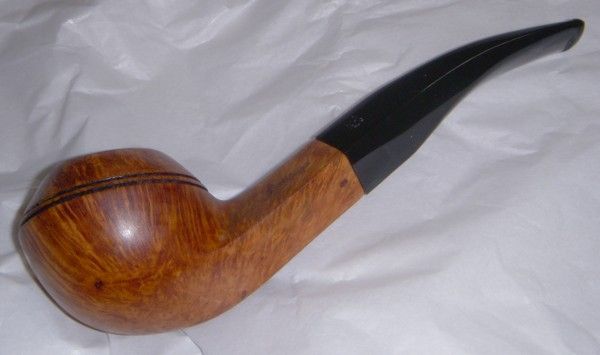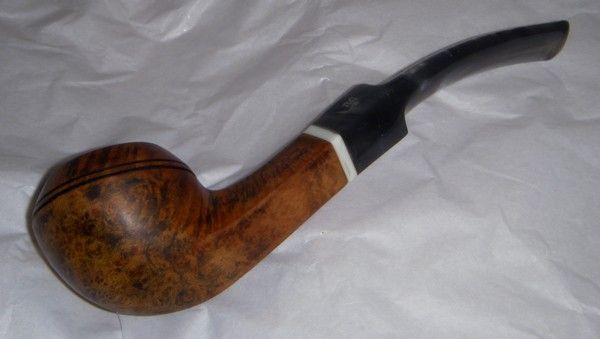





I think we can all pretty much agree on the "breathing" characteristics of briar, but what I want to ask here is about the pores - some say that over time from heavy smoking, the pores get clogged up and the pipe loses its ability to provide a good smoke - while others say that a well-kept pipe will last indefinitely and continue to provide a good smoke regardless of how many times its been smoked.
From my experience, I believe a pipe can last indefinitely. This belief is based solely on one pipe though, so it's far from any conclusive evidence on the subject. I have an old estate Royal Danish (Stanwell 2nd) that had the holy hell smoked out of it, rode real wet and put up hard - but amazingly, that things smokes sweeter than a dream every single time. There's no telling what it would look like if I sawed it in half to see what the wood looked like, but I don't think it really matters what the inner bowl wall wood looks like, it's still bringin' me the magic!
This is where we could talk about cake. Just exactly how porous is cake? Does cake affect the "breathability" of the wood? Does tar really get clogged in the pores? Or does each heating cycle act as a catalyst to "liquify" any tar from its solid state?
Fred Hanna writes:
"Briar may not be as permeable as some seem to think. Mark Tinsky once told me that he did an experiment with a few briar blocks to see how much moisture they would absorb. He immersed the air-cured blocks in water for several days and afterwards cut them open, only to reveal hardly any penetration at all. A friend once, in the heat of an argument over how much tobacco penetrates the briar to the outside walls of a pipe, determinedly cut one of his very darkened old pipes in half with a saw. The insides of the bowl walls were light and untouched by tobacco. on the other hand, some pipe makers have told me that the wood is indeed permeable, so I am not sure what to believe on this point."
Rick Newcombe writes:
"One other issue that needs to be addressed is the question of how long a briar pipe will last. Many American collectors answer that the pipes effectively will last forever -- because there is no way to smoke them so much that they stop functioning. But I think this is wrong.
Lars Ivarsson and Jess Chonowitsch, two of the greatest pipe makers in history, argue persuasively that the pores of the wood become clogged or totally "filled up" with repeated smoking. If you were to cut such a pipe bowl in half, they say, you would see instantly that there would be no way for the wood to "breathe". The inside of the wood would be totally darkened and charred."
Jan Zeman says this:
"The absorption quality of briar depends on its density. The hard, heavy block will absorb the moisture much slower then soft and light block would. This is best seen when we pipe makers apply the spirit based stain of dark color and it seeps or penetrate the wall of the bowl in seconds, and will show up as dark spots inside the tobacco chamber. Mind you in my opinion this is more of a case of extremely soft and loose grain rather then overall density of the block."
RD Field has a nice little write-up called What Makes A Good Briar Pipe, and says this:
"age - it is generally recognized that in order to have a superior smoking pipe the briar from which it is made must be at least fifty years old. It is only with age that the briar root becomes tight enough, dense enough to withstand both the heat of lighted tobacco and the juices produced during smoking for very long periods of time. Whereas the pores of less-aged briar tend to clog from absorption in a relatively short time the well-aged briar absorbs much less in a given smoke and so should last for decades if well-treated by the smoker."
http://www.rdfield.com/Articles/What%20Makes...,%20part%201.htm
And this from a tobacconist website:
"Superior Briar pipes do two things very well: They absorb heat and moisture from the combustion of tobacco. The microscopic pores in the wood expand and contract, although the wood is very densely grained. Not all briar pipes have porosity, and superior pipes are judged light in weight, regardless of the size of the bowl. I have seen, smoked and hefted very large pipes that were light as a feather. The reason: the best cured briar wood is free of bitter saps and resins, either cured out of the wood by the briar mill by boiling it out, by the pipe makers, either by curing in dry air for a few years, or by a gradual heat in a drying kiln, or by oil curing, all methods or combinations of said methods exuding the undesirable saps and resins out; resulting in a dry, porous, lightweight pipe."
http://www.outwesttobacco.com/Cool_Smoke.htm
"clogged pores" were also an issue for Dunhill:
In the early 1900's, Alfred Dunhill noticed that the pipes coming in from France were highly varnished and consequently clogged the pores of the briar. They were simply not doing justice to his creative blending.
Thus he opened his own pipe-making factory in 1910.
http://www.smokingpipes.com/pipes/new/dunhill/history.cfm
GL Pease writes:
"As a pipe is smoked, the heating of the wood causes the small capillaries to open, and moisture, one of the byproducts of combustion, is wicked away into the pores of the wood. Briar, and indeed all wood, is more absorbent when warm than when cool."
http://glpease.com/BriarAndLeaf/?p=95
A really interesting short scientific study was done called "Characteristics of Briarwood" and included along with their findings are some fantastic images from a scanning electron microscope, they include pictures of the stem, the root and the burl (they call the burl a tumor) and you can clearly see the pores, the burl contains many more pores than either the stem or root.
They quote another study done by Cormio in 1944, where he describes the microscopic characteristics as "that the wood is diffuse-porous with small, numerous, solitary and fairly uniformly distributed pores (vessels)."
It's interesting to read, and the photomicrographs are really cool to see.
http://www.rmperkins.com/RMPerkins/Miscellaneous/CharacteristicsOfBriar.pdf
:
Anybody got 2¢ to throw in on the subject?
:










